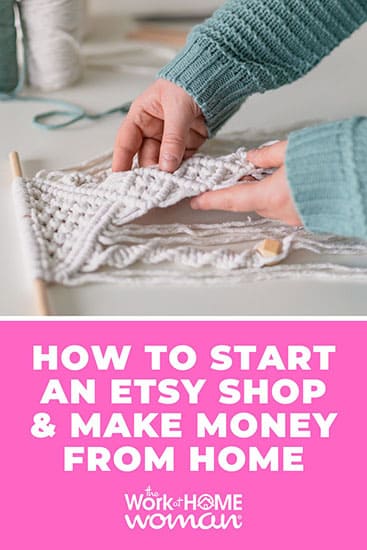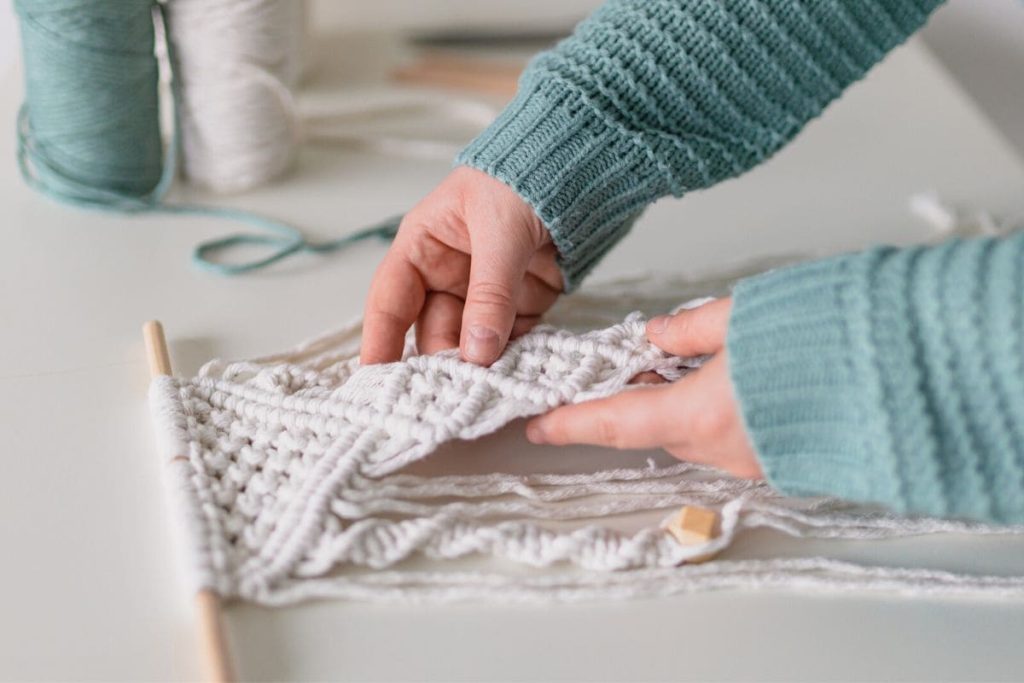
Making money from your craft can be a great source of income, and thanks Etsy MarketplaceYou can make a part-time or full-time living as an Etsy seller.
Shoppers are always looking for cute, unique and handmade items on Etsy. If you enjoy being creative and want to make money from home, this could be a great option for you.
Whether you are a jewelry designer, pattern maker, artist, toy maker, printable designer, t-shirt maker, and more, you can find buyers on the Etsy platform who want your handmade products.

And did you know you can also sell vintage items, craft supplies and print-on-demand products there? The options are virtually endless when using an Etsy account.
In this article, you’ll learn about what to sell on Etsy, fees associated with an Etsy account, how to set up your Etsy account, tools to use with your shop, and more! Hopefully this will set your business up for success.
Ideas for what to sell on Etsy
Before setting up your Etsy store, you’ll want to brainstorm store ideas. The possibilities are endless, and depending on trends, some items will sell better than others. Unlike other ecommerce sites, Etsy is a marketplace that brings buyers to you. You don’t have to worry about outside traffic.
when you to be able to Use social media like Facebook and Instagram to help sell, you don’t there is If you land on a hot category on Etsy that isn’t very saturated, consider using some outside marketing. Etsy brings you traffic if you optimize your shop with the right keywords.
Some ideas for trending categories on Etsy:
- marriage
- jewelry
- clothing
- Vintage items
- Paper and party supplies
- Home and residence
- printable
- Art and collectibles
And this is just a start. Drill down into each category to find an idea of what’s popular right now
You can use a tool called everb To peek at your competition and see what’s trending in their stores. This will help you see which of your ideas might sell well at other stores, giving you insight into whether they will sell well at yours.
There are other great tools for research Marmalade, eRankAnd Samurai Sales.
Some shop ideas:
- Personalized jewelry
- Seasonal t-shirts or sweatshirts (you can use print-on-demand with Etsy!).
- Bridesmaid Jewellery
- Nursery Art
- Crochet Patterns
- Cricut project
- Vintage Ring
- Christian-themed art
- Boho Art
- Printable (Made with Canvas)
- sticker
- the planner
- And much more!
An Etsy Business Breakdown
If you’ve never heard of Etsy, you may be clueless about how it works as an online marketplace. Etsy is a marketplace where small-business owners list their items for sale and drive traffic to their shop through Etsy keywords and SEO, which is search engine optimization. This allows shops to take advantage of Etsy’s built-in traffic to fuel sales.
You can also run Etsy ads if you don’t want to rely solely on organic search results with SEO. It’s not necessary, but it can help bring in more sales if you’re in a highly competitive market.
Advantages of selling on Etsy:
- Easy to set up and maintain
- Built-in customer pool
- Low listing fees
- Trusted shopping platform
- Print-on-demand integration (if you want to sell PODs)
- Set up Square to sell in person
- Set up your website easily with Etsy
- Coupons are easy to set up
- You can run a sale on your list
- Accept Etsy gift cards
- Setting up your storefront is easy
- Use shipping labels through Etsy
- And finally, good support should you have any questions
Basic Etsy Fee Overview
There are fees associated with starting an Etsy shop. They are pretty straightforward, and you’ll find them listed below
You’ll notice Etsy advertising fees are on a pay-per-click (PPC) basis, but you can set your advertising budget within your store.
Enrollment fee – $0.20 per listing
Transaction fees – 6.5% of total sales price
Etsy Advertising Fees – This is on a pay-per-click basis. You set your budget, and Etsy will serve your ad in search results.
Offsite advertising – Fees depend on your sales volume. At this time, you can opt out of offsite ads in your account backend
Payment processing fees – When using Etsy Payments, if you are located in the US you will be charged a flat rate of $0.25 plus 3% of the final sale price. (This will be different outside the US.)
You can Google “Etsy Fees Tool” to find free tools that allow you to input your listing details and get detailed information about all the fees and costs associated with selling your item.
Some may wonder, why use Etsy if they have so many fees? It’s a valid question, and the answer is that Etsy is a huge marketplace, bringing in more than 96 million buyers worldwide. When you use the power of Etsy Search to show up in their search engine, you can tap into Etsy’s traffic to drive sales.
This is similar to Google when websites optimize their websites to appear in Google search results When you optimize your shop to show up in Etsy search results, you tap into built-in traffic without the need to advertise your shop in other ways.
A guide to setting up your Etsy store
1. Choose your Etsy shop name
Your store name can be up to 20 characters long. You’ll want to make sure the name is something you want to keep because, at this point, you’re limited to how many times you can change the name. And once you’ve established your shop, getting a name change approved by Etsy is challenging.
Pro tip: Consider the keywords that your customers will use to purchase your items in your store and include it with the store name if possible. You don’t want to cram a bunch of keywords into your store name, but if you sell resume templates, for example, a name like “Quick and Easy Resume” would be better than something like “Angel Templates.”
However, don’t get so hung up on the name that it prevents you from opening your store right away. Getting your store up and running is more important than finding the perfect name.
2. Steps to opening your store
- Click Sell on Etsy.
- Click Start.
- Go through the short questionnaire.
- Click start your store.
- Choose your store preference. This will take you through questions including store currency.
- Input your store name.
- Choose how you’ll be paid. Add your bank account information. You’ll also need to enter your social security number.
- Add your credit card details. This is how you pay your fees.
- Create your list. You only need one listing to open a store.
- Open your store.
3. Design your store
You’ll click on the store icon, then scroll down and click on your store name at the bottom left of the screen. This will open your store page.
Click on the Edit Shop link, which is available near your header.
You can now edit your store design.
Your store design includes the following:
- Header logo
- Adding a header under your store name
- Editing where your store is located
- Adding a shop icon
- Adding a welcome message to your store page
- Choose any list you want to feature in the highlighted section
- And add your photo, shop bio, and link
Pro tip: For whatever reason, the entire store banner size shows a size that makes the banner look blurry. The correct size for a full-size banner is: 3360 x 840 pixels

4. Store Policy
You can click on the Store Policy button, which will open the Policy section. This allows you to edit existing policies In addition to being able to create your policy, you can edit the following:
- Returns and Exchanges
- cancellation
- Privacy Policy
- and fixed policies such as free shipping
5. Add your list
When you started your store, you had to add at least one listing, but now that your store is open and you’ve edited all your policies and designs – it’s time to populate your store with listings.
- While inside your store panel, click “Add Listing”.
- At the top right of the screen, click “Add a listing.”
- It is recommended to fill all allowed images in the list. At this time, there are 10 spots for photos.
- If you have a video of your product, it’s a good idea to add that as well.
- Add a keyword rich title.
- Fill out the “About this listing” section.
- Pick a category.
- Choose your renewal options for this list
- Describe details about the listing, item details, what they accept etc.
- If you’re using a print-on-demand company for that list, you’ll need to add a production partner to that category.
- Create and then choose a category for your item.
- Add relevant tags to your item.
- Any materials used may be listed as well.
- Add your price, available quantity and a SKU if you want to track your inventory.
- Choose any variation of the item.
- If you allow personalization of the item, you will click to add it.
- Next is the shipping price.
- And lastly your policy.
- You will click Add, which will prompt you to accept the listing fee. Once accepted, your listing will be live!
It sounds like a lot of steps, but once you get the hang of it, it goes by quickly.
Pro tip: You can choose to duplicate a list. This is a nice feature if some item details are the same from listing to listing, as it will save you time and effort when adding more listings to the store.
Start selling on Etsy today
As you can see, Etsy is a great option for many small businesses who want to make money from their creativity and crafts.
Whether you are a sole proprietor or an LLC (Limited Liability Company), Etsy is a great selling platform.
Not only is it reasonably easy to set up and navigate, it’s a powerful tool for selling your handmade products.
Many buyers trust Etsy and it overcomes a significant barrier when selling online. As a seller on Etsy, you already have the trust of buyers, which is essential to a successful online shop.
Selling products will never go out of style. This is a great option to earn money from home. And Etsy is a great marketplace and platform that can make your dream of working at home a reality.
For more Etsy tips, check out this interview with Melanie, where she shares advice for beginners getting started on Etsy.

No Comments
Leave a comment Cancel